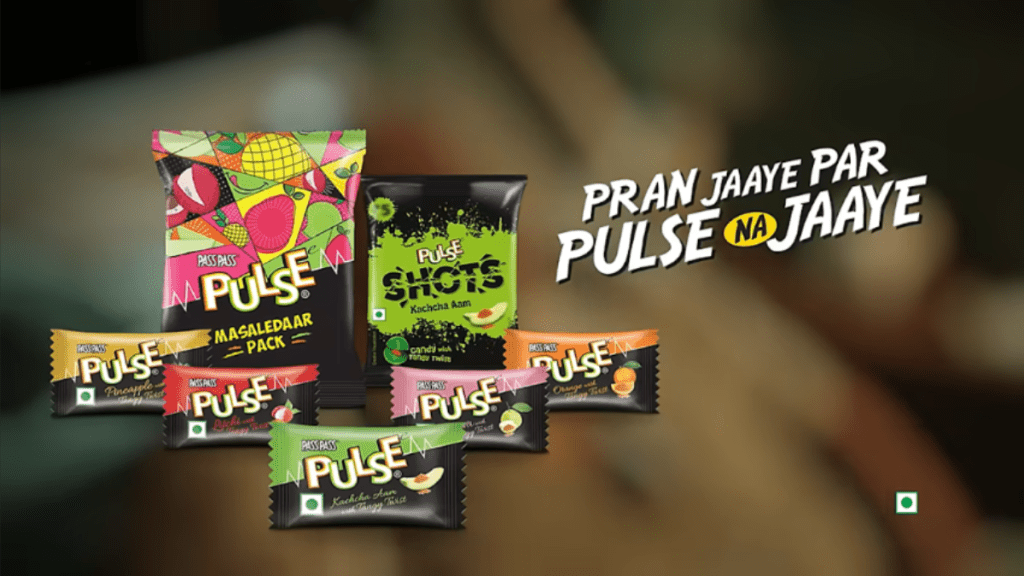The purchase of a Re 1 sugar candy is typically an impulse decision without much deliberation on the brand. More often than not, your stash of candy at home is thanks to the neighbourhood kirana store owner who ran out of change. Given just how low involvement the hardboiled candy category is, it is no easy task for a brand to make its mark.
Yet Dharampal Satyapal (DS) Group found a way to do that when it launched the kachcha aam flavoured Pulse Candy a decade ago. Less than 12 months since its launch, Pulse became a 100-crore brand and in the last fiscal, hit the 750-crore mark. Rajiv Kumar, vice-chairman of DS Group says that the brand has been growing at a 15% CAGR, higher than the industry rate of 9%. With a 19% share in India’s 4,000-crore hardboiled candy segment, citing Nielsen data, Kumar adds that the brand is a clear market leader. He expects the Pulse brand to reach the 1,000-crore mark in the next two years.
The brand doesn’t have the advertising brilliance displayed by brands like Alpenliebe. Pulse has won more on product innovation and on experience than traditional high salience marketing. The company did some clever packaging like shareable packs of candy, taking it beyond the causal impulse-driven Re1 price point. The brand’s growth in the absence of a major marketing push has also made it a case study at IIM Ahmedabad.
So what really worked for the brand? According to Kumar, its big bets with bold Indian flavours in a market filled with sweeter Western flavours, paid off well. The brand went beyond the popular target consumers for confectionery – children, and created a flavour that found appeal among adults. “Even today, brands in the category primarily target kids under 12. But for Pulse, a significant majority of the revenue comes from adults over 20 years of age,” remarks Kumar.
One of the things that stands out in the Pulse success story is that it achieved much of its growth organically with little marketing push. As Naresh Gupta, co-founder and CSO, Bang In The Middle, observes, the brand is an outlier. “It’s not that raw mango as a flavour was not launched before by candy makers, but it was never launched as a combination of sweet and salt, mimicking the taste of raw mango that most of us savoured during our childhood. The salt in the centre redefined the candy experience and till date remains the biggest reason to buy the brand,” says Gupta.
The flagship kachcha aam flavour remains Pulse’s best-selling candy, although the brand also launched variants such as guava, pineapple, orange and litchi. It recently also introduced Pulse Golmol in tamarind, once again tapping into nostalgic Indian flavour palates.
An outlier brand
Rutu Mody-Kamdar, founder of Jigsaw Brand Consultants, says Pulse has created a space for itself as an “indulgence” at a modest Re1. “Pulse stayed largely non-preachy. It relied more on word-of-mouth and schoolyard virality,” notes Kamdar, adding that the brand should consider making the masala core its signature and explore more format extensions such as lollipops and chews.
Pulse competes with brands such as Perfetti Van Melle’s Alpenliebe, ITC Candyman and Parle Products. Among these, Perfetti is the largest confectionery brand, closing FY25 at 3,500 crore. DS Group’s confectionery business, within which Pulse is a key brand, is around 1,000 crore and Kumar expects it to reach Rs 5,000 crore by FY29.
Kumar acknowledges that marketing was not a major focus for Pulse initially. “Today, our marketing spends are in line with industry benchmarks, at 6-8% of our annual revenue. In the confectionery space, below-the-line activations and distribution matter more than large above-the-line campaigns. Sampling and influencer collaborations have worked exceptionally well for us,” Kumar points out.
The company, which also operates in categories like F&B and mouth fresheners, has a robust distribution network that reaches 35 lakh outlets in the country. Kumar notes that this has given the Pulse brand an edge. The brand took another big bet operating at the `1 price point, higher than 86% of the market that sells candy at 50 paise apiece. “Consumers are willing to pay a premium for differentiated products and we saw this especially post-pandemic when people became more brand and health conscious,” he observes.
Aside from the Golmol offering, Kumar says that the Group is extending the Pulse brand into various formats like jellies, Pulse Shots (mini versions of the candy) and 5 and 10 packs.

